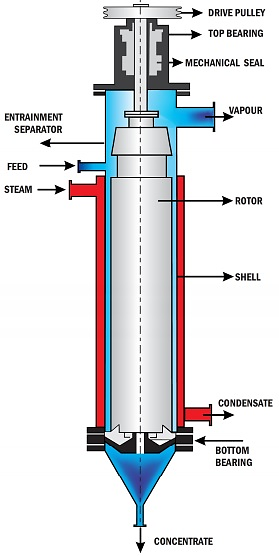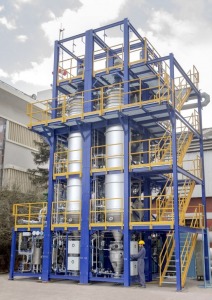The Agitated Thin Film Dryer (ATFD) is a sophisticated piece of equipment extensively utilized in various industries, including pharmaceuticals, chemicals, food processing, and notably, water treatment. This technology is designed to handle the drying of heat-sensitive materials and solutions, making it particularly valuable in processes where maintaining the integrity of the product is crucial. In the context of water treatment, ATFDs play a pivotal role in the efficient management and disposal of wastewater by converting liquid waste into dry, manageable solids.

From an engineering standpoint, the ATFD is constructed to maximize heat transfer efficiency while minimizing the residence time of the product within the dryer. The primary components of an ATFD include a cylindrical shell, a rotor with attached blades, a heating jacket, and a vacuum system.
Cylindrical Shell: The cylindrical shell serves as the main body of the ATFD. It is typically made of stainless steel to resist corrosion and withstand high temperatures. The inner surface of the shell is heated, either by steam or thermal oil, to provide the necessary heat for drying.
Rotor and Blades: Inside the cylindrical shell, a rotor equipped with blades that rotate at high speeds. These blades are designed to spread the feed material into a thin film over the heated surface of the shell. The blades can be either fixed or hinged, depending on the specific design of the ATFD. The high rotational speed of the rotor ensures that the feed material is continuously agitated, preventing the formation of hot spots and ensuring uniform drying.
Heating Jacket: The heating jacket surrounds the cylindrical shell and provides the necessary thermal energy for the drying process. The heat is transferred through the shell to the thin film of feed material, causing the solvent (usually water) to evaporate.
Vacuum System: To enhance the drying efficiency and protect heat-sensitive materials, the ATFD operates under a vacuum. The reduced pressure lowers the boiling point of the solvent, allowing it to evaporate at lower temperatures. This is particularly beneficial for drying materials that would degrade at higher temperatures.
The operation of an ATFD is based on the principles of heat transfer and mass transfer. The scientific method of action can be broken down into several key steps:
Feed Distribution: The feed material, which is typically a slurry or solution, is introduced into the ATFD through a feed distributor. The distributor ensures that the feed is evenly spread onto the inner surface of the cylindrical shell.
Film Formation: As the rotor blades rotate, they spread the feed material into a thin film over the heated surface. The thickness of this film is critical for efficient drying, as a thinner film allows for better heat transfer and faster evaporation.
Heat Transfer: Heat is transferred from the heating jacket through the cylindrical shell to the thin film of feed material. This heat causes the solvent in the feed to evaporate. The high surface area-to-volume ratio of the thin film enhances the rate of heat transfer.
Evaporation: Under the reduced pressure of the vacuum system, the solvent evaporates at a lower temperature. The vaporized solvent is then removed from the ATFD through a vapor outlet.
Product Discharge: The dried product, now in the form of a powder or flakes, is continuously scraped off the inner surface of the shell by the rotor blades and discharged from the ATFD.
Application in Water Treatment

In the context of water treatment, ATFDs are employed to handle the drying of sludge and other waste materials generated during the treatment process. The primary objective is to reduce the volume of waste, making it easier to handle, transport, and dispose of. The use of ATFDs in water treatment can be categorized into several key applications:
Sludge Drying: One of the most common applications of ATFDs in water treatment is the drying of sludge. Sludge is a byproduct of various water treatment processes and contains a significant amount of water. By using an ATFD, the water content in the sludge can be significantly reduced, resulting in a dry, manageable product. This not only reduces the volume of waste but also minimizes the cost and environmental impact of disposal.
Zero Liquid Discharge (ZLD) Systems: ATFDs are integral components of Zero Liquid Discharge (ZLD) systems, which aim to eliminate liquid waste by converting it into solid waste. In ZLD systems, the ATFD is used to dry the concentrated brine or slurry produced during the treatment process. The dried solids can then be safely disposed of or further processed for resource recovery.
Effluent Treatment Plants (ETPs): In effluent treatment plants, ATFDs are used to treat industrial wastewater by removing the water content from the effluent. This is particularly important for industries that generate large volumes of wastewater with high concentrations of dissolved solids. The use of ATFDs in ETPs helps in achieving compliance with environmental regulations by reducing the volume of liquid waste and facilitating the recovery of valuable resources.
Improvement of Water Treatment Processes
The incorporation of ATFDs in water treatment processes offers several advantages that contribute to the overall efficiency and effectiveness of the treatment system:
Volume Reduction: By converting liquid waste into dry solids, ATFDs significantly reduce the volume of waste that needs to be handled and disposed of. This not only lowers disposal costs but also minimizes the environmental footprint of the treatment process.
Resource Recovery: The dried solids produced by ATFDs can often be further processed to recover valuable resources. For example, in the case of industrial wastewater, the dried product may contain metals or other materials that can be recycled or reused.
Energy Efficiency: The use of a vacuum system in ATFDs allows for drying at lower temperatures, which is more energy-efficient compared to conventional drying methods. This is particularly beneficial for heat-sensitive materials, as it prevents thermal degradation and preserves the quality of the product.
Operational Flexibility: ATFDs are highly versatile and can be used to dry a wide range of materials, from slurries to pastes and solutions. This flexibility makes them suitable for various applications in water treatment, including the treatment of different types of wastewater and sludge.
Improved Product Quality: The continuous agitation and thin film formation in ATFDs ensure uniform drying and prevent the formation of hot spots. This results in a high-quality dried product with consistent properties.




.gif)
